Lou’s Views
News & Views / May Edition
Calendar of Events –

Riverfest Celebration
June 29th
Conway SC
Held along the Waccamaw River in downtown Conway the festival celebrates Independence Day since 1980 with music and events for the entire family.
For more information » click here

N.C. 4th of July Festival
July 4th
Southport
The patriotic spirit of America is alive and well in the City of Southport. For over 200 years this small maritime community has celebrated our nation’s independence in a big way. Incorporated as the N.C. 4th of July Festival in 1972 the festival committee strives to keep the focus of the festival on honoring our nation’s birthday with a little fun thrown in.
For more information » click here

Battleship Blast 4th of July Celebration
July 4th
Wilmington
.
.
Annual 4th of July Celebration at Riverfront Park in downtown Wilmington since 1981. Featured entertainment will perform from 6:00 PM to 9:00 PM, followed by fireworks at 9:05 PM launched from a barge in the Cape Fear River adjacent to the USS North Carolina Battleship. The only place you need to be this holiday is downtown Wilmington for the best view of fireworks.
For more information » click here
 Discover a wide range of things to do in the Brunswick Islands for an experience that goes beyond the beach.
Discover a wide range of things to do in the Brunswick Islands for an experience that goes beyond the beach.
For more information » click here.
Calendar of Events Island –

Concerts on the Coast Series
The Town’s summer concert series calendar has been released! Live performances featuring local musical groups will temporarily be held at the Bridgeview Park picnic pavilion on Sunday evenings from late May to early September. The concerts are free of charge.
For more information » click here
The park will be blocked from vehicular access beginning Saturday evening. The splash pad will be closed on Sundays and the multipurpose court will close at 3:00 p.m. each Sunday. No seating will be provided so everyone should bring their own chair for the event.

Tide Dyed Program
The Tide Dye program will be held on Tuesdays between 1:00 to 2:30 p.m. at Bridgeview Park picnic pavilion. Participants must be in line by 2:00 p.m. to participate because the process takes approximately 30 minutes to complete. Fee is $7 per shirt for youth sizes through Adult XL and $10 per shirt for 2XL. Payment via cash or check only.
.Beginning June 11th and continuing through August 13th
 Turtle Talk
Turtle Talk
Two programs both are held every Wednesday during the summer at Town Hall. Children’s Turtle Time is at 4:00 p.m. with crafts, stories and activities for children ages 3 – 6. All children must be accompanied by an adult. Turtle Talk is an educational program at 7:00 p.m. for everyone else. (Beginning June 19th)
Parks & Recreation / Programs & Events
For more information » click here
Reminders –
 THB Newsletter (03/30/24)
THB Newsletter (03/30/24)
Paid Parking
Paid parking will be enforced starting April 1st in all Holden Beach designated parking areas. It will be enforced from 9:00 a.m. – 5:00 p.m. daily, with free parking before and after that time. All parking will use license plates for verification.
As a reminder, Holden Beach uses the “SurfCAST by Otto” parking solution. Annual passes are now available for purchase on the mobile app. You will also be able to purchase passes by scanning the QR-codes located on the parking signs for access to https://surfcast.ottoconnect.us/pay.
Rates for the 2024 season are as follows:
$5 per hour for up to four hours
$20 per day and for any duration greater than four hours
$80 per week (seven consecutive days)
$175 per calendar year for a single vehicle (annual passes)
Handicap parking is free in designated handicap spaces and only with a valid license plate or hangtag.
Parking rates can be paid via credit card, debit card or PayPal.
Visit https://hbtownhall.com/paid-parking for more information and to view a table with authorized parking areas.

Pets on the Beach Strand
Pets – Chapter 90 / Animals / 90.20
From May 20th through September 10th it is unlawful to have any pet on the beach strand during the hours of 9:00am through 5:00pm.

Solid Waste Pick-Up Schedule
GFL Environmental change in service, trash pickup will be twice a week.Starting the Saturday before Memorial Day through the Saturday after Labor Day: Pick-up is every Tuesday and Saturday from May 25th through September 30th
Please note:
. • Trash carts must be at the street by 6:00 a.m. on the pickup day
. • BAG the trash before putting it in the cart
. • Carts will be rolled back to the front of the house
GFL Refuse Collection Policy
GFL has recently notified all Brunswick County residents that they will no longer accept extra bags of refuse outside of the collection cart. This is not a new policy but is stricter enforcement of an existing policy. While in the past GFL drivers would at times make exceptions and take additional bags of refuse, the tremendous growth in housing within Brunswick County makes this practice cost prohibitive and causes drivers to fall behind schedule.
Solid Waste Pick-up Schedule –
starting the Saturday before Memorial Day (May 25th) twice a week
Recycling –
starting after Memorial Day (June 4th) weekly pick-up
Curbside Recycling – 2024
GFL Environmental is now offering curbside recycling for Town properties that desire to participate in the service. The service cost per cart is $106.88 annually paid in advance to the Town of Holden Beach. The service consists of a ninety-six (96) gallon cart that is emptied every other week during the months of October – May and weekly during the months of June – September.
Curbside Recycling Application » click here
Curbside Recycling Calendar » click here

Trash Can Requirements – Rental Properties
GFL Environmental – trash can requirements
Ordinance 07-13, Section 50.08
Rental properties have specific number of trash cans based on number of bedrooms.
* One extra trash can per every 2 bedrooms
..
§ 50.08 RENTAL HOMES.
(A) Rental homes, as defined in Chapter 157, that are rented as part of the summer rental season, are subject to high numbers of guests, resulting in abnormally large volumes of trash. This type of occupancy use presents a significantly higher impact than homes not used for summer rentals. In interest of public health and sanitation and environmental concerns, all rental home shall have a minimum of one trash can per two bedrooms. Homes with an odd number of bedrooms shall round up (for examples one to two bedrooms – one trash can; three to four bedrooms – two trash cans; five – six bedrooms – three trash cans, and the like).
Building Numbers
Ocean front homes are required to have house numbers visible from the beach strand.
Please call Planning and Inspections Department at 910.842.6080 with any questions.
§157.087 BUILDING NUMBERS.
(A) The correct street number shall be clearly visible from the street on all buildings. Numbers shall be block letters, not script, and of a color clearly in contrast with that of the building and shall be a minimum of six inches in height.
(B) Beach front buildings will also have clearly visible house numbers from the strand side meeting the above criteria on size, contrast, etc. Placement shall be on vertical column supporting deck(s) or deck roof on the primary structure. For buildings with a setback of over 300 feet from the first dune line, a vertical post shall be erected aside the walkway with house numbers affixed. In all cases the numbers must be clearly visible from the strand. Other placements may be acceptable with approval of the Building Inspector.
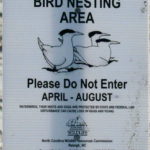 Bird Nesting Area
Bird Nesting Area
NC Wildlife Commission has posted signs that say – Bird Nesting Area / Please don’t disturb. The signs are posted on the west end beach strand around 1335 OBW.
.
People and dogs are supposed to stay out of the area from April through November
. 1) It’s a Plover nesting area
. 2) Allows migrating birds a place to land and rest without being disturbed

A Second Helping
.
Program to collect food Saturday mornings (8:00am to 10:30am) during the summer at the Beach Mart on the Causeway.
1) Twentieth year of the program
2) Food collections have now exceeded 298,000 pounds
3) Collections will begin on Memorial Day weekend
4) Food is distributed to the needy in Brunswick County
For more information » click here
.
Hunger exists everywhere in this country; join them in the fight to help end hunger in Brunswick County. Cash donations are gratefully accepted. One hundred percent (100%) of these cash donations are used to buy more food. You can be assured that the money will be very well spent.
Mail Donations to:
A Second Helping
% Sharon United Methodist Church
2030 Holden Beach Road
Supply, NC 28462
Storm Events –

Hurricane Vehicle Decals
Property owners will be provided with four (4) decals which were included in their April water bills. It is important that you place your decals in your vehicle or in a safe place. A $10 fee will be assessed to anyone who needs to obtain either additional or replacement decals. Decals will not be issued in the 24-hour period before an anticipated order of evacuation.
The decals are your passes to get back onto the island to check your property in the event that an emergency would necessitate restricting access to the island. Decals must be displayed in the driver side lower left-hand corner of the windshield, where they are not obstructed by any other items. Officials must be able to clearly read the decal from outside the vehicle.
Property owners without a valid decal will not be allowed on the island during restricted access. No other method of identification is accepted in an emergency situation. Click here to visit the Town website to find out more information regarding decals and emergency situations.
EVACUATION, CURFEW & DECALS
What is a State of Emergency?
A proclamation by the Town which enacts special ordinances and/or prohibitions during emergency situations to protect the public, public health and property. These prohibitions can include limitations on movement, curfews, directing of evacuations, controlling ingress and egress to the emergency area, alcoholic beverages, and more. State of Emergencies are issued in accordance with N.C.G.S. 166A-19.22.
What is a curfew?
A curfew is an order, typically during a State of Emergency, which requires all persons in the affected areas to remain on their own property. During a curfew, you are not free to move about public domain areas or on others’ property. Violations of a curfew could lead to arrest in certain situations.
What is a voluntary evacuation?
A voluntary evacuation creates a recommendation for all parties in the affected area to get their affairs in order hastily and evacuated.
What is a mandatory evacuation?
A mandatory evacuation means you must leave the area in which an order has been issued. With recent changes to the laws in North Carolina, you no longer have the option of staying in an area under an order of mandatory evacuation.
Why is the sewer system turned off during a storm/event?
Often the sewer system is turned off during storms which have the potential to create significant flooding on the island. The system is turned off to protect its integrity. If it were left on, it could pose a significant threat to the public health. When the system is manually shut down, it also greatly reduces the time needed to bring it back up after an event which equates to getting residents and guests back on the Island much faster.
Why is there a delay for decal holders to get back on the island once a storm ends?
After a storm, many things must occur before even limited access can be allowed. Some of those things include making sure the streets are passable; the sewer system must be restarted to comply with State laws; the utilities (water, sewer, electricity, propane supplies) must be checked to ensure no safety risk are present; and the post-storm damage assessment team needs to perform an initial assessment.
Where can I get up-to-date information during and after a storm or State of Emergency?
You can sign up for the Town email service by clicking here. The newsletter, along with the Town’s website will be the main sources of information during an emergency situation. Links to the Town’s official Facebook and Twitter pages can be found on the website. You can also download our app for Apple and Android phones by accessing the app store on your smart phone and searching Holden Beach.
Please refrain from calling Town Hall and Police Department phone lines with general information questions. These lines need to remain open for emergencies, storm management and post-storm mitigation. All updates concerning re-entry, general access, etc. may be found on the Town’s website and other media outlets.
Why do I see others moving about the island during a curfew?
If a curfew order is in place, you must stay on your own property. You may see many other vehicles moving about the Island. We often receive assistance from other local, state, federal and contract personnel during events. It is likely these are the personnel you are seeing, and they are involved in the mitigation process for the event. Please do not assume that a curfew order has been lifted and/or you are free to move about the island.
Can I check my friends’ property for them?
If a curfew order is in place, you may ONLY travel to your personally owned property. Traveling about the Island to check on others’ property is not allowed. is in place, you may ONLY travel to your personally owned property. Traveling about
Who can obtain decals?
Only property owners and businesses who service the island can obtain a decal.
How do I get decals for my vehicle…?
If I am an owner?
Decals will be mailed out in water bills to property owners before the season starts. Those owners who need additional decals can contact Town Hall. A fee may apply, please check the current fee schedule.
If I am a renter?
You must contact the owner of the property to obtain a decal.
If I am a business owner on the Island?
You must contact Town Hall to obtain a decal.
If I am a business owner off the Island that provides services on the Island?
You must contact Town Hall for eligibility and to obtain a decal.
When does my decal expire?
All decals expire on the last day of the calendar year as indicated on the decal.
Where do I put my decal on my car?
Decals must be displayed in the lower left-hand corner of the windshield, where they are not obstructed by any other items to include window tinting, other decals, etc. Officials must be able to clearly read the decal from outside the vehicle. Please note that re-entry will not be allowed if a current, intact decal is not affixed to the windshield as designated.
How do I replace a decal if I get a new vehicle?
If you trade a vehicle or otherwise need a replacement decal, you may obtain them from Town Hall during normal business hours. A fee may apply, check the current fee schedule.
Can I obtain a decal right before an emergency occurs?
While most of the storms we deal with are tropical in nature with some type of advanced warning, we do experience many other types of events that could create a State of Emergency without warning. All eligible parties should obtain decals as early as possible each year to avoid being denied access to the Island. Decals shall not be issued during the 24-hour period prior to an anticipated order of evacuation so staff can concentrate on properly preparing the Town for the storm/event.
Can I use a tax bill or another document for re-entry?
No. You MUST have a decal to re-enter the Island until it is open to the general public.
How does re-entry after a storm during a State of Emergency work?
The bridge is closed to all vehicle access, except for official vehicles. Once those with proper decals are allowed access, they must conform with the current rules in place by the specific State of Emergency Order. After all hazards have been rendered safe, the bridge will be opened to the general public. A curfew could remain in effect however, to ensure the safety and security of the Island and its residents and guests. Please understand this process typically takes days to evolve and could be significantly longer, depending on the amount of damage sustained. Please refrain from calling for times for re-entry, as those are often not set on schedule. Instead, stay tunes to local media outlets and official social media accounts for accurate updates.
How can I check on my property if access is limited to the Island?
Once it is safe, property owners with valid decals will be allowed back on the Island after a storm/event. At this point, you can travel to your property, in accordance with the rules of the specific State of Emergency Order currently in place.
If you live out of the area, please do not travel to the Island until you are certain you will be allowed access. Stay tuned to those media outlets and email services that are of official nature for this information. Also, be certain you have your current, valid decal properly affixed to your vehicle.
It is a good idea to be sure your contact information is current with the Town tax office as this is the location Town officials will use in the event you need to be contacted.
For more information » click here
NC General Statute 166A-19.22
Power of municipalities and counties to enact ordinances to deal with states of emergency.
Synopsis – The governing body may impose by declaration or enacted ordinance, prohibitions, and restrictions during a state of emergency. This includes the prohibition and restriction of movements of people in public places, including imposing a curfew; directing or compelling the voluntary or mandatory evacuation of all or part of the population, controlling ingress and egress of an emergency area, and providing for the closure of streets, roads, highways, bridges, public vehicular areas. All prohibitions and restrictions imposed by declaration or ordinance shall take effect immediately upon publication of the declaration unless the declaration sets a later time. The prohibitions and restrictions shall expire when they are terminated by the official or entity that imposed them, or when the state of emergency terminates.
Violation – Any person who violates any provisions of an ordinance or a declaration enacted or declared pursuant to this section shall be guilty of a Class 2 misdemeanor.
Turtle Watch Program –

Turtle Watch Program – 2024
The first nest of the 2024 season was on May 18th
Average annual number of nests is 57
Members of the patrol started riding the beach every morning on May 1 and will do so through October looking for signs of turtle nests.
For more information » click here
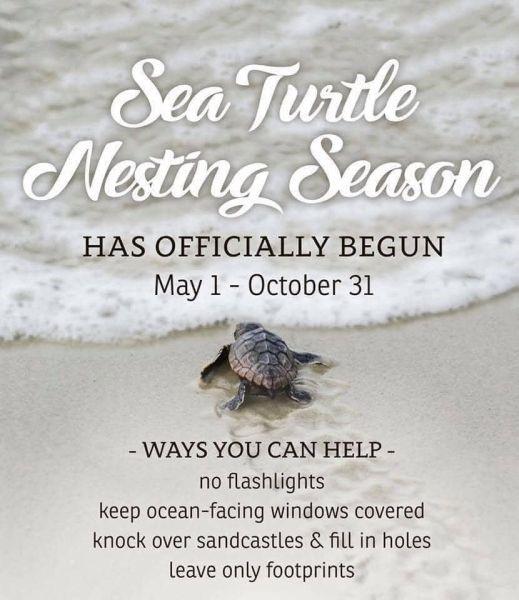
First sea turtle nests of the season found on Holden Beach
The first sea turtle nests of the season on Holden Beach were discovered Saturday, May 18, according to the town. According to the town announcement, one nest was found Saturday, and two more, as well as a “false crawl,” were located on Sunday. “The season is off and running with a big start!” Holden Beach states on Facebook. “All three nests were left in place where the mother laid them. We can expect to see hatchlings from these nests in mid to late July.” A false crawl occurs “when a sea turtle comes ashore to lay eggs but returns to the water without depositing them due to various reasons including visual or noise disturbance or less-than-ideal nesting conditions,” according to the North Carolina Department of Environmental Quality.
During sea turtle nesting season, Holden Beach asks residents to:
- Turn off ocean-facing lights each evening
- Fill any holes you dig on the beach
- Bring in beach equipment each evening
“Holden Beach is a turtle sanctuary–that means a safe place for sea turtles,” the town explains. “… these all can be hazards and distract the mother turtles as they make their way onto the beach to lay their eggs.”
Read more » click here
Facebook
Update from the HB Turtle Patrol – The turtles are here! The first nests on Holden Beach were laid this weekend. On Saturday, May 18. the early morning rider found nest #1. And then if that wasn’t exciting enough, on Sunday two more nests and one false crawl was found. The season is off and running with a big start! All three nests were left in place where the mother laid them. We can expect to see hatchlings from these nests in mid to late July. Holden Beach is a turtle sanctuary–that means a safe place for sea turtles. Please remember to turn off all ocean facing lights each evening, fill in any holes you may dig on the beach and bring all equipment in each evening—these all can be hazards and distract the mother turtles as they make their way onto the beach to lay their eggs.
For more information » click here
Dates set for summer educational programs
We’ve set our dates for our traditional summer educational programs.
Turtle Talk for all ages will be held on Wednesday evenings at 7 p.m. from June 19 through August 24.
Children’s Turtle Time will be at 4 p.m. on Wednesdays June 26 through August 7. This is for children 3-6 years old.
Both programs are free of charge and will be held at the Holden Beach Chapel.
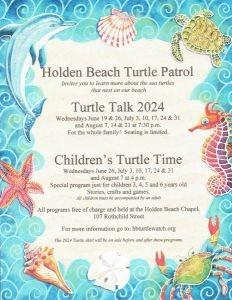
Upon Further Review –
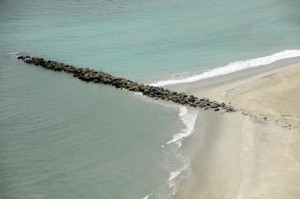
Will the N.C. coast see more terminal groins as erosion continues and sand gets scarcer?
More than a decade after N.C. law was changed to allow the construction of terminal groins, why have only two been built along the coast?
During the middle of President Barack Obama’s first term in office, North Carolina made one of the biggest changes to how it manages oceanfront development since the adoption of the Coastal Area Management Act (CAMA). State legislators approved a bill that softened North Carolina’s long-standing prohibition on hardened structures along the beachfront except in very specific cases, such as to protect historic buildings. The legislation, Senate Bill 110, specifically allowed up to four “test” terminal groins − later increased to six − to be built along the coast. The controversial decision, reinforced by Gov. Bev Perdue allowing it to become law without her signature, ended a 30-year state ban and decades of discussion among property owners, coastal officials, environmentalists and scientists over the best way of dealing with shifting sands on inherently unstable barrier islands amid the need to protect often very expensive beachfront properties. A dozen years later, how has the move impacted the N.C. coast? Or has it?
What is a terminal groin?
A terminal groin is a hardened structure placed at a right angle out from the beach into the ocean and is generally built close to an inlet or at other high-erosion area. Unlike jetties, which are usually built in pairs on either side of a channel or inlet, terminal groins are low-slung structures designed to allow waves to pass over them. Groins also are often built of stone, which allows water to pass through them. Terminal groins work by trapping sand that moves parallel to the beach in near-shore waters. The result is a buildup of the beach on the updrift side of the groin. If enough sand is captured and held by the groin, the structure is often buried, becoming visually little more than a bump on the beach.
Why are they controversial?
By capturing sand that travels down the beach near to shore, a groin depletes the sand supply to the beach area immediately down-drift of the structure. In response, down-drift property owners often seek to install their own groins to counteract the increased erosion in front of their oceanfront homes, leading to a cascading effect of groin installation along the beach. In effect, the groin is robbing sand from one part of the beach to help build up another part. Those concerns prompted state regulators to enact North Carolina’s hardened-structure ban in the 1980s. But some coastal officials, backed by worried property owners, said the state’s existing erosion-control methods − namely expensive beach nourishment projects and ugly temporary sandbags − were ineffective, especially around inlets, and towns needed another “tool” in the beach-management toolbox to deal with disappearing beaches in high-erosion areas.
What’s happened with terminal groins?
Two new terminal groins have been built since the law was changed last decade. Bald Head Island built a terminal groin to help deal with chronic erosion woes along the west end of south beach. The groin was finished in 2016 after village residents approved an $18 million bond to finance the project. Ocean Isle Beach started construction of its terminal groin on the island’s eastern end to counteract chronic erosion woes tied to nearby Shallotte Inlet in late 2021. The Brunswick County town had initially won federal approval to build the groin in 2017, but the project was challenged by the National Audubon Society. The case was decided in the town’s favor in early 2021. The $11 million project, originally estimated to cost around $9.5 million, was funded through a special town account to pay for beach projects and a portion of Ocean Isle’s accommodation tax on rentals. Both Ocean Isle and Bald Head officials in the past have praised the work the terminal groins have done in stabilizing the beach and helping protect oceanfront properties and infrastructure.
What about groins in other towns?
A number of other coastal communities have or are considering terminal groins, but no new projects are currently moving forward. Figure Eight Island, a wealthy private enclave squeezed between Wrightsville Beach in New Hanover County and Lea-Hutaff Island in Pender County, had long been leading the charge to allow terminal groins to be built along the North Carolina oceanfront. A terminal groin on Figure Eight was seen as a way of dealing with erosion at the island’s north end caused by the meandering Rich Inlet. But plans for a structure were finally shelved in 2017 after island property owners rejected funding the proposed groin. Holden Beach also has kicked the tires on building a terminal groin to counteract the disappearing beach and help protect threatened homes on the island’s eastern end near Lockwood Folly Inlet. But after the costs of building and maintaining the groin, including periodic injections of fresh sand, were shown to cost north of $30 million over 30 years, the town’s commissioners voted to withdraw their permit application with the Army Corps of Engineers. North Topsail Beach in Onslow County for years also has studied the possibility of building a terminal groin at the town’s north end to help stabilize the battered beach near New Inlet. The chronic erosion has left dozens of homes along the beach relying on sandbags for protection from the encroaching ocean. But the high cost of building and maintaining such a structure coupled with erosion woes in other parts of the town have seen those plans put on the back burner for now. Most recently, Oak Island officials have raised the idea of studying the feasibility of constructing a terminal groin on their beach’s west end near Lockwood Folly Inlet. Sick of seeing fresh sand pumped onto the beach simply washing away after a few weeks or months, town officials wondered if a groin would offer a more permanent, cost-effective solution to the chronic erosion problem that’s left more than a dozen homes relying on sandbags for protection. But at a workshop in January the town’s engineering firm warned that any groin project would take years of studies before construction could begin, and the building and future maintenance of the structure would be expensive.
Will more terminal groins get built in N.C.?
That remains to be seen. But as beach quality sand becomes scarcer to access in near-shore areas and more communities eye the same sand resources, forcing some to look farther offshore to find material to nourish their beaches, the idea of building a terminal groin could resurface as part of the solution facing beach towns in risk of losing parts of their most important asset. Still, the cost factor is likely to be a big deterrent for all but the most wealthy coastal communities, said Dr. Robert Young, director of the Program for the Study of Developed Shorelines at Western Carolina University. He said that while a terminal groin might help stabilize a portion of the beach, it in no way diminishes the need for expensive nourishment projects to rebuild other parts of the beachfront. Sand also need to be periodically placed around the groin to counteract the impact of altering the natural processes that the sand would follow if the structure wasn’t there. “I haven’t seen conclusive evidence over the long run that terminal groins are going to save communities money, which is one of the primary reasons for building them,” Young said. “I think the jury is still out on that.” He also noted that terminal groins can capture sand that’s meant to curl around an inlet, creating the shoals and sandy spits that shorebirds and many humans enjoy visiting − something that can be lost or severely impacted to protect homes along just one part of a beach. “It’s an amenity that adds value to everyone else who likes to walk the beach,” Young said of those inlet shorelines. “A terminal groin becomes an obstruction to that in your community.”
Read more » click here
Corrections & Amplifications –
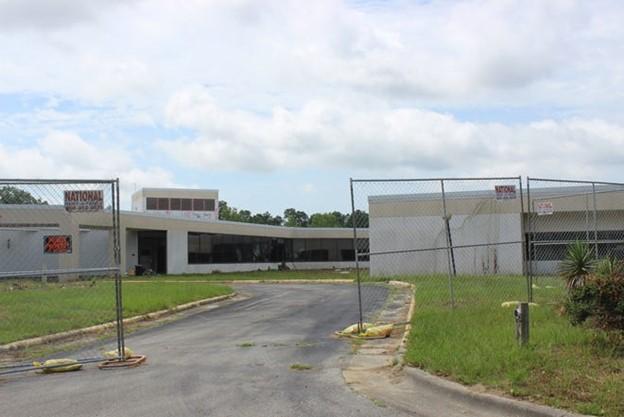
Brunswick Community Hospital
Brunswick to get new rehab facility on old hospital site
After sitting vacant for several years, the former Brunswick Community Hospital in Supply will soon be renovated into a rehabilitation center. According to a news release from Todd Hughes, founder and owner of Medaci Wellness Institute, the substance use disorder treatment center looks to renovate the former hospital site at 14 Medical Center Drive into a “state-of-the-art rehabilitation center.” Brunswick Community Hospital ceased operations when Novant Health opened a new hospital in July 2011. The building has since sat largely empty, attracting vandals and deteriorating from lack of maintenance. In 2022, Tea Real Estate, Inc., a property tax real estate company based in Falls Church, Virginia, and owned by Hughes, purchased the site from its previous owner, Centennial Services LLC. At the time, Hughes noted there were “no firm plans” for the property’s future. Now, the 25-year healthcare veteran looks to combine his healthcare and real estate backgrounds to transform the space into a rehabilitation center. “When completed, our mission is to provide the highest quality, evidence-based substance abuse treatment and a comprehensive range of rehabilitation services, including medically supervised detoxification, individual and group therapy, holistic wellness programs and aftercare support, empowering individuals to achieve lasting recovery,” Hughes stated in the release. According to Medaci Wellness Institute’s Facebook page, demolition at the site began earlier this year. According to the release, LS3P Wilmington, an architecture firm, will design the facility and Wilmington-based general contractor Thomas Construction Group will lead construction. The 73,000-square-foot building sits on 34 acres of land.
Read more » click here
Previously reported – December 2012
Commissioners have been trying to sell or lease the property since ownership of the hospital reverted to the county more than a year ago when the hospital closed and moved to the New Brunswick Novant Medical Center a few miles north of the former hospital location. This is the third group to submit an offer to purchase the aging hospital facility since commissioners started the process to sell the hospital facility, citing the costly upkeep of the property and its grounds. The sale package includes the old hospital off U.S. 17 at Supply, the 32-acre site, three ancillary buildings and five medical office suites.
Previously reported – September 2013
Potential buyer restarts upset bid process for county hospital
County commissioners agreed Sept. 3 to accept a $750,000 offer for the former Brunswick Community Hospital property. But the potential agreement is just the first step in the process of selling the hospital, which has fallen through in the past. North Carolina statute requires the county to advertise the property under an upset bid — a competing buyer can make a better offer. The hospital property was deeded to Brunswick County in September 2011. After the hospital reverted back to the county, the first bidder for the property was Crown Management LLC with a $500,000 offer. The county didn’t accept the bid hoping, to sell the facility and the land for at least $1.5 million. Crown Management, which planned to convert the former hospital into an acute-care psychiatric treatment center and residential facility, submitted another bid for $1.5 million. The company withdrew its $1.5 million bid in April, but in June, Crown Management resubmitted its bid and had plans to move forward with the treatment center. In July, commissioners accepted an upset bid of $1,575,050 from Jacobs Real Estate Advisors LLC and Katierich Asset Management LLC. County officials received a $1.75 million offer from East Coast Lands One LLC for the old county hospital in October 2012, but a deal could not be closed.
Previously reported – July 2015
Former hospital building sold
The former Brunswick Community Hospital was formally sold Friday for $750,000 to a Raleigh development company. The county board of commissioners ratified the sale during an emergency meeting held at noon Friday. The building, built in 1979 and vacant since 2011, will be turned over to Centre Development Company II, which was formerly Excel Medical Development, County Attorney Huey Marshall said.
Read more » click here
Deal done for former hospital site
The sale of the former Brunswick Community Hospital closed Tuesday, according to a release from the county. Centre Development Company LLC bought the old hospital for $750,000. Brunswick County has owned the building since 2011, when Novant Health opened a new building on U.S. 17. Bobby Lewis, one of the building’s new owners, said in the release that there has been interest in the building from convalescent care, drug treatment care and the Wounded Warriors Project. “Brunswick County is a perfect site for convalescent care,” Lewis said in the release.
Read more » click here
Previously reported – December 2016
Former Brunswick hospital site sold; mental health facility planned
The old Brunswick Community Hospital property has another owner with new plans for the nearly 32-acre parcel off U.S. 17, which has been sitting vacant for the last five years. Past owner Centre Development Co. II LLC sells property for $1.6 million to a group that plans to convert the facility into a behavioral and mental health facility.
Read more » click here
Previously reported – July 2022
What’s next for the old Brunswick hospital property after it was sold in a complex deal?
For years, the building that once housed Brunswick Community Hospital has remained empty, attracting vandals and deteriorating from lack of maintenance. But the property’s new owners hope to change that. Tea Real Estate, Inc., a property tax real estate company based in Falls Church, Virginia, purchased the site in March from its previous owner, Centennial Services LLC. The deed from the sale reflects an excise tax of $1,000, which is figured at a rate of $2 per $1,000 of the sales price. This equates to a sales price of $500,000. Todd Hughes, the owner of Tea Real Estate, explained that it was a “complex deal,” and the $500,000 was a down payment. The purchase includes the former hospital building and the surrounding land, which totals just over 31 acres, located in Supply with road frontage on U.S. 17. Records from the Brunswick County tax office show that the property was recently assessed at over $1.7 million, and it last sold for $1.6 million in 2016. Brunswick Community Hospital ceased operation at Medical Center Drive when Novant Health opened a new hospital, located near Supply, in July 2011. Since that time, there have been several different ideas floated for the old hospital site. Most recently, Palms Health and Wellness LLC used a portion of the building as a mental health and drug treatment center, but that clinic has since closed. In a prepared statement, Hughes said Tea Real Estate provides education for real estate investors and matches investors with properties through nontraditional investment options and plans. He also said that there are “no firm plans” about the hospital’s future tenants or business, but he did note that it would be renovated and “suited for specialized healthcare for the residents of Brunswick County and the surrounding areas.” “Not only will the facility be renovated to a state-of-the-art healthcare services site, but it will also provide economic development, multiple jobs in the healthcare arena and give Supply, North Carolina a newly renovated healthcare service system of care,” the statement reads. Renovations are expected to begin in late September 2022. Hughes said updates would be provided to the community once plans for the property’s use have been finalized.
Read more » click here
Odds & Ends –
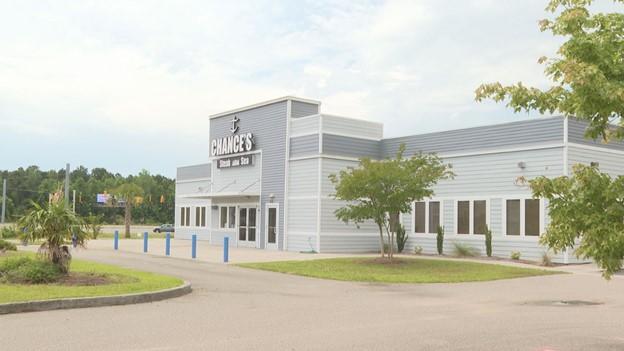
This former Brunswick County restaurant is being repurposed
A former restaurant building in Shallotte will soon be repurposed into a funeral home. Since the popular Chance’s Steak and Sea restaurant closed in April 2023, its former home at 4690 East Coast Lane in Shallotte has sat empty. But seemingly not for much longer. At its March meeting, the Shallotte Board of Aldermen approved a special use permit allowing the property, which is located in the town’s highway business zoning district, to be used as a funeral home. The property has been a restaurant space since 2012, housing Chance’s Steak and Sea most recently and operating originally as a Golden Corral. The restaurant’s former owner, David Chance, cited the difficult labor market as one of the reasons for the spring 2023 closure. According to a real estate listing, the building offers 7,900 square feet of retail space just off U.S. 17. The building was renovated in 2020. According to the listing, the space is poised for a restaurant to move in but could also function as a doctor’s office, car lot or other retail space. To operate as a funeral home, a special use permit was required. White Funeral Home and Cremation Service is set to move its Shallotte location to the East Coast Drive property. The funeral home has been part of the Brunswick County community for over 70 years. According to its website, the business began as Coble Ward-Smith Funeral Service at its Bolivia location before the company merged with Peacock-Newnam and White Funeral Service of Southport and White Funeral and Cremation Service of Shallotte in 2015. The Shallotte location is currently located off Express Drive, but the company looks to move operations to the former restaurant space. SCI Shared Resources, LLC, submitted the application for the special use permit. The funeral home is part of the Dignity Memorial network, which is owned by the LLC. Before the permit could be granted, the applicant had to prove the use would be in harmony with the surrounding uses. While there are other types of businesses around, such as the nearby Smithfield’s Chicken ‘N Bar-B-Q, the applicant noted there are two other funeral homes located close by: Brunswick Funeral Service and Peoples Funeral Home. Alderman Larry Harrelson owns a property adjacent to the site, so he recused himself from the discussion and vote. The board ultimately voted unanimously to grant the special use permit.
Read more » click here
This and That –
 These NC cities have the most expensive homes in North Carolina
These NC cities have the most expensive homes in North Carolina
Stacker compiled a list of cities with the most expensive homes in North Carolina using data from Zillow. Cities are ranked by the Zillow Home Values Index for all homes as of March 2024.
Purchasing a home is among the most important investments a person will make in their lifetime. More than a place to live, homeownership is an asset with the potential to tremendously rise in value. But with home prices reaching record heights, affordability plays a huge role—and, increasingly, is a huge barrier—for buyers. In March, the typical home value in the United States was $355,696—4.6% higher than the previous year. High mortgage rates have also had a major impact on affordability: As of April 25, the 30-year fixed mortgage rate stands at 7.17%, three points higher than the average mortgage American households are sitting on. That disparity has kept many people in homes they might otherwise leave—to pursue another job, to downsize, or to upsize—further squeezing an already-tight market. While home prices are up across the U.S., certain cities command significantly higher prices than others. Location, size, age, and condition are all contributing factors to home values. Stacker compiled a list of cities with the most expensive homes in North Carolina using data from Zillow. Cities are ranked by the Zillow Home Values Index for all homes as of March 2024.
Top 30 North Carolina cities with the most expensive home costs
#10. Holden Beach
- Typical home value: $896,280
- 1-year price change: +5.5%
- 5-year price change: +89.2%
Read more » click here

There’s actually no such thing as vegetables.
Here’s why you should eat them anyway
The rumors are true: Vegetables aren’t real — that is, in botany, anyway. While the term fruit is recognized botanically as anything that contains a seed or seeds, vegetable is actually a broad umbrella term for many types of edible plants. You might think you know what carrots and beets are. Carrots, beets and other vegetables that grow in the ground are actually the true roots of plants. Lettuce and spinach are the leaves, while celery and asparagus are the stems, and greens such as broccoli, artichokes and cauliflowers are immature flowers, according to Steve Reiners, a professor of horticulture at Cornell University’s College of Agriculture and Life Sciences. As for produce that grow from flowers, such as peppers and tomatoes, the hot-debated crops are botanically classified as fruits, Reiners added. Cucumbers, squash, eggplant and avocados are also classified as fruit due to their anatomy, according to the European Food Information Council.
What is a vegetable?
The term vegetable does not have a set definition when it comes to botany. However, in horticulture, the science of growing garden crops, a vegetable is defined as any herbaceous plant — a fleshy plant that completes its life cycle in a growing season — in which some portion “is eaten either cooked or raw, during the principal part of the meal, and not as like a snack or dessert,” Reiners said. The legal definition of a vegetable versus a fruit — at least in the United States — was determined during a 19th century US Supreme Court case that concluded that the tomato is a vegetable. While vegetables are really just the roots, stems and leaves of plants, experts don’t recommend eating just any roots, stems and leaves. One example is rhubarb. The fleshy stalk is the edible part of the plant, but the leaves are poisonous, Reiners said. Stay safe by eating plants that grocery stores commonly call vegetables. “We know (vegetables) are healthy. We know the vitamin content, we know the mineral content,” Reiners said. “We know how much fiber is in all of it. “We also know that the vegetables that you either grow or you’re purchasing at a farmers market or grocery store are safe to eat,” he said.
Eat your vegetables
By understanding the various parts of vegetables and the nutrients they carry, people can eat well, according to Sherri Stastny, a registered dietitian and a professor in the department of health, nutrition and exercises sciences at North Dakota State University. A head of broccoli is a great source of nutrients, but the stem of the green, which is more commonly thrown out, is also rich in fiber and nutrients, Stastny said. The regular consumption of flowery produce such as broccoli and cauliflower have been found to be associated with a decrease in the risk of cancer, she added. “Heart disease is still the No. 1 killer in the United States, and we know that if you eat enough fruits and vegetables, you lower your risk for heart disease — and that goes along with obesity, diabetes and all these other chronic diseases,” Stastny said. It is important to eat a variety of vegetables since each one will have varying beneficial nutrients, she added. Dark leafy greens such as spinach and kale are great sources of certain phytonutrients, natural nutrients from plants that are beneficial to human health, that help to maintain sharp eye vision, while carrots will help to strengthen night vision. “If you think of the richest, darkest, most colorful vegetables, that’s where you’re going to find those (nutrients),” Stastny said, while potassium-rich vegetables and fruit, such as potatoes, pumpkin and squash, could help to lower and maintain blood pressure.
‘Start them young’
For parents looking to get young kids to eat their fruits and veggies, breaking down the anatomy of the plant, while describing the colors, taste and texture, could be a fun and educational way of introducing the nutrient-dense foods to the early explorers. “Start them young,” Stastny said. “If you introduce children to vegetables at a younger age … they’re more likely to eat vegetables throughout their lifespan and therefore decrease the risk of chronic disease.”
Read more » click here
Factoid That May Interest Only Me –
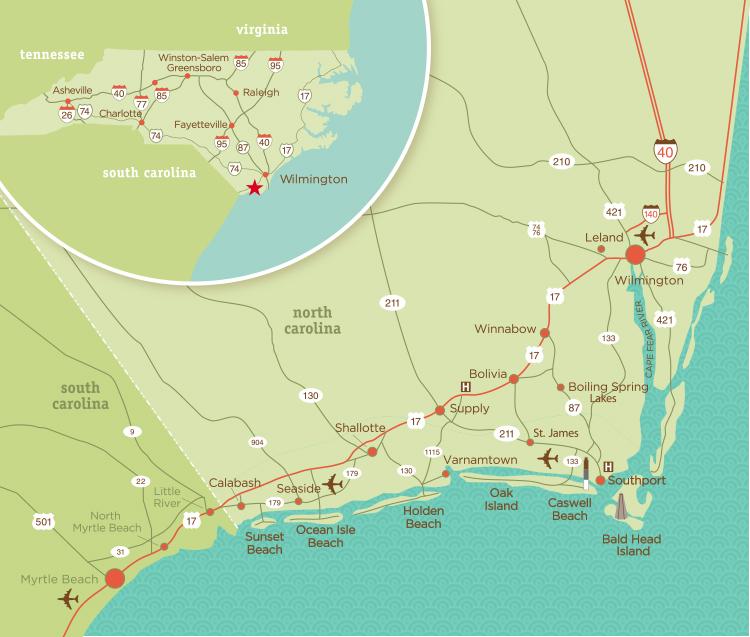 Living along the NC coast is increasingly risky.
Living along the NC coast is increasingly risky.
So why are property values still rising?
A new economic model suggests that tax incentives and federal subsidies help fuel coastal property price increases despite growing climate change risks, like sea-level rise
Anyone who has dreamed of owning a property at the beach knows that it’s a goal shared by many. Couple in the growing popularity of coastal living in general − the Wilmington-area’s population jumped from 200,000 in 1990 to more than 450,000 in 2020 − and home ownership is increasingly becoming the privilege of the rich and the few. According to a report by online research publisher Stacker using real estate data from Zillow, Wrightsville Beach has seen a nearly 74% increase in property values over the past five years, with the typical home value now pushing an eyewatering $1.46 million. That makes it the most expensive town in the state, with Bald Head Island a close second with a 76% increase in values in the past five years increasing the average home on the Brunswick County island to $1.3 million. Of the top ten priciest locales in North Carolina, six are coastal communities. But are government actions helping bake in the advantages that high-income property owners have in reaching the coastal dream even as evidence mounts that the risk from climate change and sea-level rise is making living along the ocean an increasingly risky proposition? That’s a question North Carolina researchers attempted to tackle in a recent study published in Nature Communications that looked at how economic incentives and subsidies are impacting coastal property markets. Dr. Dylan McNamara, professor of physics and physical oceanography at the University of North Carolina Wilmington and one of the study’s authors, said the changes occurring along much of the U.S. coast can’t be viewed as just uniquely physical or uniquely economic. “They are linked, a coupled human environmental system where the environment is impacting humans and humans are impacting the environment,” he said. Dr. Martin Smith, an environmental economics professor at Duke University, and McNamara created a new economic model called the Coastal Home Ownership Model (C-HOM) to analyze the long-term evolution of coastal real estate markets. Smith said government actions to protect and enhance coastal communities from environmental risks, such as sea-level rise and stronger and more frequent hurricanes, helps support and boost property values. “What it signals to the market is that this is a fine place to further invest,” he said. Paradoxically, as property values increase and coastal communities become more wealthy, it becomes easier for officials to justify additional and more expensive projects to maintain that economic value in these increasingly vulnerable areas. “We’re shielding these markets from the underlying risks they face, and hence propping up these markets,” McNamara said.
Subsidized sand
Take the history and role of beach nourishment projects, for example. When Congress decided to get the federal government involved in the beach-building business nearly six decades ago, the thinking was oceanfront communities would only require sand roughly once every 10 years or so. The cost of these federal projects would be split between Washington and local governments, with the federal government picking up most of the tab and the state and/or local communities paying the rest. As erosion has increased thanks to sea-level rise and more frequent storms, that’s now been reduced to every couple years − a timeline that doesn’t include federal emergency beach-building projects after major storms. And as more towns see their beaches washing away and confront the high costs of nourishment, thanks to sand scarcity and increased environmental regulations, there is a growing chorus of communities who want their own federal nourishment project. Currently, New Hanover County’s three beach towns and Ocean Isle Beach in Brunswick County are the only North Carolina communities that are guaranteed a periodic injection of fresh sand largely funded by the federal government. Critics say beach nourishment projects funded by federal taxpayers are bad long-term investments that literally just wash away, only benefit rich oceanfront property owners, and have to be repeated every few years to be truly effective. Backers claim beach-building projects are vital to keeping coastal economies running, protecting oceanfront properties and vital infrastructure, and helping communities hit hard by hurricanes rebound.
Analyzing the trade-offs
Both McNamara and Smith said there’s no doubt taxpayer-subsidized projects like beach nourishments have short-term and even medium-term economic benefits. But the cost of defending the shoreline, while propping up property values, is itself increasing. That means more of those costs need to be shouldered by state and local governments if they have the necessary political will and the deep pockets. McNamara and Smith also warn that those rising costs, which beach towns will increasingly have to pass on to their residents or private property owners will have to fund themselves, coupled with surging property values will likely increase the gentrification of many coastal communities − a process that’s already occurring in many beach towns. Some North Carolina coastal communities are already facing these tough decisions. In 2022, North Topsail Beach pulled out of a federal beach nourishment project with Surf City over cost concerns, and Dare County has told residents of Rodanthe, an unincorporated community on Hatteras Island that has some of the highest erosion rates along the entire N.C. coast, that it simply can’t afford to nourish the village’s eroding beach that has already swallowed several homes. Increasing home and flood insurance premiums also are heaping additional pressures on many coastal residents. With the impacts from climate change expected to get worse in the coming decades, the researchers said change is coming. How officials manage the long-term economic adjustments required to adapt to an evolving environment so that they don’t all hit at once could be key to sustaining some of these coastal communities. ”As markets begin to sniff out those impacts, which is to say as the risk begins to increase, values will begin to go down,” McNamara said. “So, the question is when do we see that trajectory, and what path will it take.” Potential options the researchers suggest include managed retreat, possibly including the idea of a purchase and buy-back program so owners can continue to “rent” their homes until they have to move, and building smaller, movable structures that can more readily react to the rising ocean levels instead of the McMansions that are increasingly proliferating along the coast. “There are certainly trade-offs,” Smith said, “but we want people to have a clear view of what those trade-offs are.”
Read more » click here
Beach Strand –
 As weather warms, nesting shorebirds and sea turtles join people heading to NC’s beaches
As weather warms, nesting shorebirds and sea turtles join people heading to NC’s beaches
With people flocking to the coast, officials hope education and outreach can help efforts to share the sand with nesting birds and sea turtles.
As the weather warms, sun-seeking tourists aren’t the only ones drawn to North Carolina’s rich necklace of barrier islands along its 320 miles of coastline. If you’re visiting the beach this summer, there’s a good chance you’ll see wildlife mixed in with visitors and the occasional resident. But sharing valuable beach real estate with nesting shorebirds and sea turtles can be challenging. Mix in the loss of habitat on many islands to development, the growing risk from climate change, and the increased threat of disturbance tied to human activities, dogs and even predators and the odds are often stacked against the native fauna. The eggs and chicks of nesting shorebirds often blend in perfectly with the sand, making it easy for people or pets to accidentally step on them. Getting close to the nests or babies can be just as bad, scaring the parents off and leaving the eggs and chicks at the mercy of predators and the summer heat. That’s where groups like the N.C. Wildlife Resources Commission and Audubon North Carolina come in to help level the playing field. Hundreds of signs ring the state’s coastal nesting sanctuaries from Currituck Sound in the north to Sunset Beach in the south, warning visitors to respect nesting areas. In some locations, including Wrightsville Beach, volunteers help reinforce that message. Hope Sutton, eastern wildlife diversity supervisor with the wildlife commission, said education and outreach efforts are some of the most powerful tools officials have to raise awareness about the birds’ requirements. “It’s a critical component, whether its students at Wrightsville Beach Elementary making cute signs to warn beachgoers to stay out of the refuge or adults learning about these birds through one of our outreach activities,” she said. “Our behavior patterns can really impact the chance of success many of these birds species have.” The helping hand comes as regulators worry about the future of some of the state’s shorebirds. North Carolina’s 2023 waterbird survey, which is conducted every three years and is a collaborative effort among government agencies and environmental groups, showed substantial dips in the numbers of many nesting shorebirds. Among wading birds, that list included cattle egrets, tricolored heron, little blue herons, snowy egrets and glossy ibis. Beach-nesting species showing substantial declines included the common tern, gull-billed tern, and Caspian tern. Another species that is in trouble is the black skimmer, with North Carolina’s population decreasing by half since 1999. Because skimmers nest directly on the open sand, they are especially vulnerable to disturbance and loss of nesting sites. But the survey wasn’t all bad news. Least tern numbers were found to be increasing, with many of the nests found on the beaches at the south end of Wrightsville Beach and on Lea-Hutaff Island in Pender County. Brown pelicans also are doing well, with 5,227 nests reported in 2023, well above the 15-year average of about 4,000 nests. Many of the shorebirds holding their own nest on spoil islands, like those in the Cape Fear River or Intracoastal Waterway, or on sections of protected natural areas like Masonboro Island that are hard to access. But climate change is an unknown variable that could add to the pressure many species face. On low-lying manmade dredge islands, for example, rising seas and stronger tropical storms tied to warming temperatures could increase erosion and over wash threats. “And the competition for sand is already tough and is likely to get worse in the coming decades,” Sutton said, referring to the limited nearshore sand resources and many coastal towns now seeking nourishment projects to boost their eroding beaches. A warming climate also could prompt some birds to nest sooner. Lindsay Addison, a coastal biologist with Audubon North Carolina, said learning to share the beach and knowing when to back away, such as when a shorebird starts acting irritated, can go a long way to help. “Anyone who has lived down here for a while knows that there are more and more people now, and sometimes it’s really hard to go anywhere along the coast and not run into a lot of people,” she said. “The birds also are experiencing that, and there are a lot of opportunities for people to disturb them and impact their survival. “But if we just keep our distance and take some other steps, like keeping our dogs on a leash during certain times, it can make a really huge difference.” Shorebird nesting season runs from March through mid-September.
Turtle time
Shorebirds aren’t the only ones looking to nest on area beaches. Peak sea turtle nesting season begins May 1 and continues through the end of October. Most local beaches are monitored daily during sea turtle nesting season to look for evidence of nests, which are then monitored and protected if needed during the roughly two-month incubation period. While sea turtle nesting numbers have been showing increases in recent years, regulators and environmentalists warn the marine reptiles still face many threats − especially during the decades they navigate the oceans before females return to their birth beach to nest. While on the beach, threats dangers include holes dug in the sand and left by beachgoers, which can trap hatchlings after they emerge from the nest, and bright lights from homes and businesses that can distract nesting mothers and hatchlings and lead them away from the ocean.
Sharing the beach
Tips from the N.C. Wildlife Resources Commission on how to share the beach with nesting wildlife this summer:
- Respect the boundaries of the roped-off nesting areas
- Keep dogs on a leash
- Follow beach driving regulations
- Throw away trash properly, including fishing line and kite strings
- Don’t feed sea gulls or least terns
- Don’t fly drones or kites near nesting sites
Read more » click here
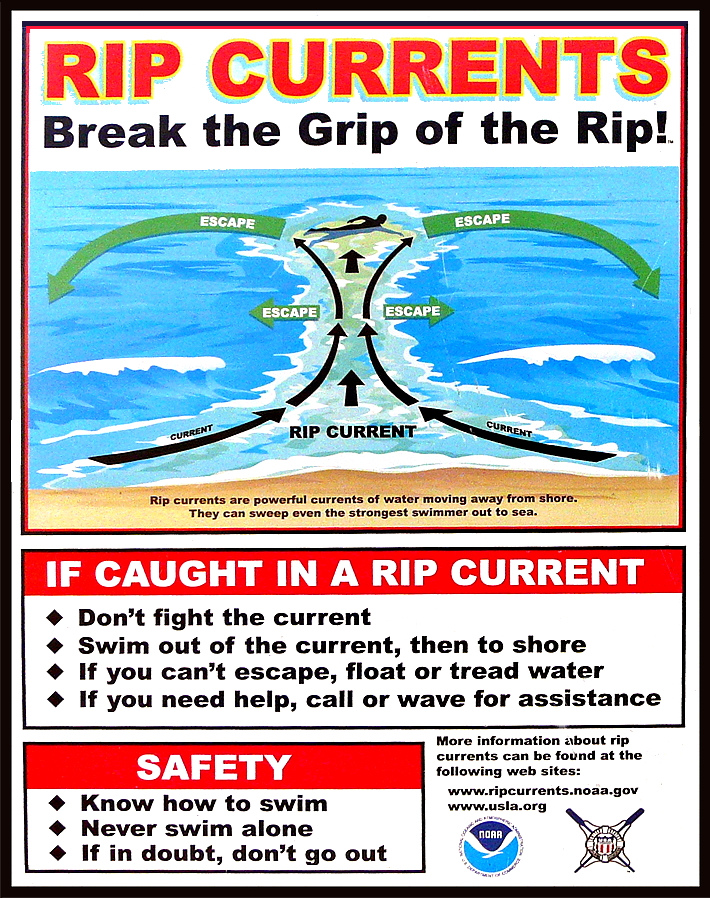
Most rip current deaths are preventable. Yet people keep drowning.
Beach-safety experts are frustrated by the mounting fatalities despite awareness campaigns and improved forecasts
Rip-current deaths in the United States are running ahead of last year’s pace — at least 29 since the beginning of the year — with peak beach season yet to come. Experts are warning the public to be aware of this largely hidden hazard ahead of Memorial Day weekend, traditionally one of the busiest beach weekends of the year. The risk of dangerous rip currents is expected to be particularly high this weekend along portions of the Southeast coast where a storm could produce heavy rain, gusty winds and rough seas. Experts say most rip-current fatalities can be prevented. Still, the number of annual rip-current deaths has steadily climbed since the National Weather Service began tracking them in 2010, reaching a record of 130 in 2021, then dipping to 85 last year. Rip currents were the third-leading cause of weather-related deaths from 2012 to 2021, behind only heat and flooding, according to the Weather Service, and in a typical year they kill more people than lightning, hurricanes or tornadoes. Rip currents are strong, narrow streams of water that flow away from the shoreline and can suddenly sweep swimmers out to sea. They can form on almost any beach with breaking waves, especially near low spots or breaks in sandbars, and near jetties or piers. Predicting where and when a rip current will form is difficult because of the many weather and ocean factors involved. The Weather Service cautions that “rip currents often form on calm, sunny days.” The Weather Service lists 26 rip-current deaths this year through April 27, not including three deaths believed to be caused by rip currents on April 28 in Destin, Fla., May 6 in Ocean City, Md., and May 12 at Cannon Beach, Ore. At this point last year, there were 19 total such deaths. Beach-safety experts are expressing frustration as fatalities trend higher again this year despite annual awareness campaigns, such as the United States Lifesaving Association’s National Beach Safety Week held every year during the week before Memorial Day, and recent improvements to rip current forecasts. “It is frustrating when we produce videos and graphics and educational information and release it at the beginning of each beach season, and it still misses so many people,” Scott Stripling, a senior meteorologist at the National Hurricane Center in Miami, said in an email. “The problem seems to be one of communication and/or lack of attention by the general public.”
Rip-current forecasts and warning signs
The Weather Service issues daily rip-current forecasts for beaches on the Atlantic Ocean, Gulf Coast, Southern California, Great Lakes, Puerto Rico and the U.S. Virgin Islands. The forecasts categorize the rip-current risk as low, moderate or high, and are informed by a rip-current model recently developed by NOAA that has made it possible to differentiate the risk between adjacent beaches. Previously the same forecast could span 100 miles or more. However, the model doesn’t enable reliable forecasts of the exact location and time of rip currents. These are influenced by a number of factors including wave characteristics, water levels, winds and the shape of a beach. Advances in artificial intelligence could help with rip-current detection — NOAA is partnering with the Southeast Coastal Ocean Observing Regional Association on a project using AI to detect rip currents in webcam imagery — but such efforts are still in their infancy. In some cases, there are visible clues to the existence of a rip current, such as a break in the waves, foamy water or objects being carried offshore, or darker water that is due to a break in a sandbar. Often, though, rip currents are difficult to see, or are best seen from a high point such as a dune line or the top of a beach access. Rip currents are particularly hard to spot in South Florida, where, the Weather Service says, they “consistently rank at or near the top of the list of deadliest weather-related hazards,” because there is not much sediment to darken or muddy the current at the shoreline. In Brevard County alone, home to nearly 72 miles of sandy beaches, there have been eight apparent rip-current drownings since November, all at beaches without lifeguards. “We have clear-water rips, so these offshore-flowing currents are very hard to detect,” Stephen Leatherman, a professor in the department of earth and environment at Florida International University, said in an email. “The best thing is to have lifeguards and for people to swim close to lifeguards. But lifeguards are very expensive, and Florida has 825 miles of good quality sandy beaches which are swimmable for most of the year.”
Warnings and tips for surviving a rip current
Rip currents flow at speeds up to 5 miles per hour. That may not sound fast, but it’s faster than many Olympic swimmers. If you are caught in a rip current, experts say not to swim directly back to shore against the current, which can quickly exhaust and drown you. Instead, swim parallel to the shore until you are out of the current, which is typically no wider than about 50 to 100 feet. You might also escape by floating or treading water, allowing the current to take you out just past the breaking waves where many rip currents tend to dissipate, and then circulate you back toward the shore. However, some rip currents can extend hundreds of yards offshore. If you see someone caught in a rip current, experts urge you not to risk your own life to attempt a swimming rescue unless you have been trained to do so and have a flotation device to assist you and the person in distress. Instead, you should get help from a lifeguard or call 911 if no lifeguard is present. You should also throw the victim something that floats, such as a lifejacket, body board, cooler or a ball, and yell instructions on how to escape. Experts agree that the best way to survive a rip current is to avoid it in the first place. That means checking the rip-current forecast before you enter the water, heeding warnings for rip currents or rough surf, and only swimming close to a lifeguard. The United States Lifesaving Association estimates the chance of someone’s drowning at a beach with a lifeguard at 1 in 18 million. “Lifeguards are trained to spot rip currents and other beach hazards and intervene as and when needed,” Chris Houser, a professor at the University of Windsor School of Environment and a longtime beach-safety researcher, said in an email. “While there is some evidence that individual beach users can be trained to spot rips, most beach users are not aware of what to look for.” U.S. lifeguards make an estimated 80,000 or more rip-current rescues each year, which suggests that education and warning messages are not reaching or are not resonating with as many people as experts would like. “If the lifeguards are flying precautionary flags, and there are signs on the lifeguard stand identifying the potential for rips in that area, and the National Weather Service and media have advertised that there is at least a moderate risk for rip currents to be present at your local beach, what else can we do?” the Weather Service’s Stripling said.
Read more » click here

 Staying safe at the beach: Rip currents, jellyfish, sharks, and other hazards
Staying safe at the beach: Rip currents, jellyfish, sharks, and other hazards
A trip to the beach can turn deadly (or painful) due to natural hazards but being aware of risks and mitigating hazards is a good way to prevent problems.
Picture this: warm weather, blue skies, and your toes in the sand — it sounds like a perfect lazy summer day at the beach. Maybe you decide to cool down in the ocean and find yourself bobbing around when suddenly you realize you are a little too far out. As panic sinks in and you start to swim towards dry land you realize your efforts are in vain and your whole body is getting tired, all the while you are drifting further into the Atlantic — you have gotten stuck in a rip current. It’s not the only potential danger in the ocean, though. There are also sharks. And, of course, there are some things on shore that ruin your day at the beach, too, including stepping on jellyfish and, of course, good old-fashioned sunburn.
Rip currents
According to the U.S. Lifesaving Association (USLA), 80 percent of all ocean rescues are related to rip currents and annually more than 100 fatalities across the country are due to rip currents. While it is obvious that swimming at a beach with lifeguards is one of the safer options, there are plenty of area beaches that lack lifeguards or maybe ocean rescue season has not started just yet. So, what is the best course of action for surviving a rip current? According to the National Weather Service, there are several things swimmers should keep in mind when dealing with these often-unseen dangers.
- Relax. Rip currents don’t pull you under.
- A rip current is a natural treadmill that travels an average speed of 1-2 feet per second but has been measured as fast as 8 feet per second — faster than an Olympic swimmer. Trying to swim against a rip current will only use up your energy; energy you need to survive and escape the rip current.
- Do NOT try to swim directly into to shore. Swim along the shoreline until you escape the current’s pull. When free from the pull of the current, swim at an angle away from the current toward shore.
- If you feel you can’t reach shore, relax, face the shore, and call or wave for help. Remember: If in doubt, don’t go out!
- If at all possible, only swim at beaches with lifeguards.
- If you choose to swim on beaches without a lifeguard, never swim alone. Take a friend and have that person take a cell phone so he or she can call 911 for help.
Sharks
Sharks are a fear on most every swimmer’s mind, regardless of the actual dangers posed by the large predatory fish. “NOAA states that while shark attacks are rare, they are most likely to occur near shore, typically inshore of a sandbar or between sandbars where sharks can be trapped by low tide, and near steep drop-offs where sharks’ prey gather. While the risks are small, it’s important to be aware of how to avoid an attack,” according to previous reporting.
Suggestions from NOAA for reducing the risk of a shark attack include:
- Don’t swim too far from shore.
- Stay in groups – sharks are more likely to attack a solitary individual.
- Avoid being in the water during darkness or twilight when sharks are most active.
- Don’t go in the water if bleeding from a wound – sharks have a very acute sense of smell.
- Leave the shiny jewelry at home – the reflected light resembles fish scales.
- Avoid brightly-colored swimwear – sharks see contrast particularly well.
Sunburns
Most everyone has experienced a sunburn at one point in their life and while not often thought as a major concern for many, overexposure to UV light can cause serious long-term problems including skin cancer. The Centers for Disease Control and Prevention (CDC) recommends using at least S.P.F. 15 sunscreen at least 15 minutes prior to sun exposure. Wearing a hat, long sleeves, and other protective clothing is also recommended to keep skin protected.
Jellyfish
Jellyfish and Portuguese Man of War have been spotted along the beaches of New Hanover County and surrounding area beaches already this season and the little floating creatures can pack a punch. Often times beachgoers will spot them washed up on shore and other times they can be spotted in the water, but it is best to avoid them when you can. “While all jellyfish sting, not all contain poison that hurts humans. Be careful of jellies that wash up on shore, as some can still sting if tentacles are wet. NOAA recommends that if you are stung by a jellyfish to first seek a lifeguard to give first aid. If no lifeguards are present, wash the wound with vinegar or rubbing alcohol,” NOAA suggests. And what about that … other method of treating stings? Turns out, it’s a myth. In fact, urine can actually aggravate the stinging cells of jellyfish, making things worse. These cells, which detach and stick into the skin of prey, can continue to inject venom. Urine, as well as fresh water, can cause an imbalance to the salt solution surrounding the stinging cells, causing them to continue to fire. According to Scientific American, if you don’t have vinegar or rubbing alcohol, rinsing with salt water may be your best bet.
Read more » click here

Hot Button Issues –
Subjects that are important to people and about which they have strong opinions

Climate
For more information » click here.
A streak of record global heat nears one-year mark
April marked an 11th consecutive month of record global heat, the latest sign that humans are in uncharted climate territory. But there is reason to predict planetary temperatures could moderate soon, though they would remain far above old normals because of human-caused global warming. “If 2024 continues to follow its expected trajectory, global temperatures will fall out of record territory in the next month or two,” Zeke Hausfather, a climate scientist with the payments company Stripe, wrote in a newsletter. For now, the spate of unprecedented global heat continues to be felt around the world. April began with a heat wave across West Africa that was so intense, an analysis determined it would have been “virtually impossible” without the influence of human-caused planetary warming. The month ended with a stretch of record-setting heat across Southeast Asia, with temperatures surging well above 100 degrees and up to 120 degrees in some areas from India to the Philippines. But data suggests a diminishing trend in the margins by which average global temperatures are setting records. Hausfather called it “gobsmackingly bananas” when September set a new monthly average global temperature record by an unprecedented margin of 0.5 degrees Celsius. October set a record by a margin that was nearly as large and marked what was then the hottest 12-month period ever observed. Preliminary data shows last month was 0.1 to 0.2 degrees Celsius warmer than the next-hottest April, a significant margin but relatively closer to past observations. Climate scientists said it could be a sign that the surge of global warmth over the past year is beginning to wane, if only slightly. That is because of the imminent end of a historically strong episode of the planet-warming climate pattern El Niño, which began nearly a year ago. During El Niño, warm waters pool along the equator in the eastern and central Pacific Ocean, releasing heat into the atmosphere and triggering extreme heat waves, droughts and floods around the world. Climate models suggest that a rapid switch to the relative cooling influence of La Niña appears increasingly likely this summer or fall. During La Niña, cooler-than-average surface temperatures dominate the eastern and central equatorial Pacific. That could mean this year approaches but does not quite match the record average global heat observed on an annual basis in 2023, scientists said. Berkeley Earth climate scientist Robert Rohde recently predicted 2024 would end as the warmest or second-warmest year on record. Hausfather said that while the year has so far averaged about 1.7 degrees Celsius above preindustrial levels, before the influence of humans’ fossil fuel consumption began, it is likely to end about 1.5 degrees above that benchmark. How rapidly global temperatures moderate, if at all, will be key in gauging whether climate change is accelerating, NASA climate scientist Gavin Schmidt wrote in a Nature column in March. If La Niña develops and the record warmth does not moderate, it could signal that humans have “fundamentally altered” Earth’s climate system, he said.
Read more » click here
North Carolina map shows where state could be underwater from sea level rise
An interactive map shows how parts of North Carolina could be submerged in water as sea levels rise due to the effects of climate change.
The state faces particular risks because of its barrier islands, known as the Outer Banks, its extensive coastline and its low elevation. An interactive map shows how parts of North Carolina could be submerged in water as sea levels rise due to the effects of climate change. The state faces particular risks because of its barrier islands, known as the Outer Banks, its extensive coastline and its low elevation. The United Nations’ Intergovernmental Panel on Climate Change (IPCC) projects that by the year 2100, global sea levels will have risen by between 0.95 and 3.61 feet. However, it notes that a rise of around 6.6 feet “cannot be ruled out.” If sea levels rose by just 3 feet, parts of North Carolina’s barrier islands and coastal areas would be encroached by water, according to projections by the NOAA. If sea levels were to rise to 6 feet, nearly the entire counties of Dare, Hyde and Tyrrell would be submerged. If sea levels were to rise to that level, parts of Wilmington, one the state’s largest cities which is known for its historic downtown riverwalk, would also be affected, according to the map. Some coastal parts of North Carolina are already preparing for rising sea levels. The Outer Banks town of Nags Head has said it is factoring the issue into its zoning code, stormwater and flood and dune protection. The state has also widened its beaches by pumping sand from the ocean onto its shorelines. The rates by which sea levels might rise are at this point imprecise projections and could vary depending on what actions countries take to tackle climate change and slow the melting of ice caps. David Thornalley, a professor of ocean and climate science at University College London, previously noted that 2100 was only one lifespan away, and that significant sea rises “would happen if we didn’t take steps to reduce our GHG (greenhouse gas) emissions.” NOAA oceanographer William Sweet said in a previous email to Newsweek: “NOAA’s Sea Level Rise Viewer is a versatile mapping platform that provides insights on what lies in harm’s way—either from ongoing sea level rise or flooding from full-moon tides to hurricane storm surges. “Due to decades of sea level rise, high tides are drowning wetlands and routinely flooding U.S. coastal communities, disrupting commutes and commerce and requiring extensive upgrades to public works like storm and waste-water systems.”
Read more » click here
There’s something happening here
What it is ain’t exactly clear
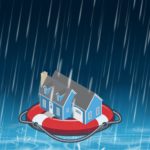
Flood Insurance Program
For more information » click here

National Flood Insurance Program: Reauthorization
Congress must periodically renew the NFIP’s statutory authority to operate. On March 22, 2024, the president signed legislation passed by Congress that extends the National Flood Insurance Program’s (NFIP’s) authorization to September 30, 2024.
Congress must now reauthorize the NFIP
by no later than 11:59 pm on September 30, 2024.

GenX
For more information » click here

Homeowners Insurance
For more information » click here
Anti-regulation sentiment may be fueling insurance crisis
When Insurance Commissioner Mike Causey met last month in Manteo for a brief overview and Q&A with community members worried about property insurance issues, he stressed that his office had limited power over building code changes and insurance company business decisions in North Carolina that have unnerved homeowners. First of all, he said, billion-dollar losses from storms, wildfires, floods and other disasters are worldwide challenges. But the property insurance industry in the U.S., where population numbers and real estate values are often highest in the highest-risk areas, is approaching its own survival crisis. “It’s a very hard market right now across the United States,” Causey said. “Companies just don’t want to write homeowners policies.”
Confronted with looming policy price hikes and feeling powerless to stop their insurance companies from pulling out of the state, frustrated homeowners are turning to the government for solutions. “People say, ‘Why don’t you change the system?’” Causey said, responding to the audience’s questions about future insurance affordability and access. “The only group that can change that system is the legislature.” Whether Causey, a Republican who is seeking reelection to the post he’s held since 2017, is shifting blame may be debatable, but it is evident from the last legislative session that focus on property insurance viability in the state was not a priority for the North Carolina General Assembly. Rather than modernizing the state’s 15-year-old residential building codes, a step incentivized by lower property insurance costs, millions in government grants, and more resilient and efficient construction, North Carolina legislators passed a law, House Bill 488, that in much of the state banned inspection of exterior sheathing in structures exposed to winds of 140 mph or less. The bill also removed authority from the North Carolina Building Code Council, a panel of industry specialists that had been working for months on updating codes, froze the old energy-efficiency standards until 2031 and directed creation in 2025 of a new separate residential council. While the legislation is certain to deprive the state of available funds for climate resilience, it is also locking homebuyers into new housing that is built to outdated standards and thus more vulnerable to climate hazards. As a result, homebuyers will have increasingly higher utility bills, as well as structures more prone to damage in weather events, ultimately making their home more expensive to own. “Everybody’s going to be paying quite a bit more for homeowners’ insurance because … our building codes are hopelessly out of date when it comes to residential construction in some areas,” said Kim Wooten, a member of the Building Code Council and the chair of the council’s ad hoc energy committee. “The other piece of this is that North Carolina is now going to lose hundreds of millions of dollars in grant money from the federal government to increase our ability to withstand flooding from flood events, storm events, weather disaster events.” The bill also allocated about $500,000 for staff members for the new residential council, which had been part of the existing Building Code Council, she said. Wooten, who was on the panel from 2008 to 2013 before rejoining about five years ago, is an engineer. Anti-regulation sentiment in the legislature as well as persistent climate change skepticism, Wooten said, has contributed to lawmakers’ resistance to updating codes. The North Carolina Home Builders Association, which lobbied for the bill, had said that sheath inspection is unneeded and, along with energy-efficiency updates, would add an average of about $20,000 in costs to a new home. But in an independent analysis Wooten conducted as part of her role with the energy committee while reaching out to green homebuilders, industry insiders and researchers, said that energy efficiency was consistently one of the five top things homebuyers want in a home — and the costs were “nowhere near” what the homebuilders claim. “They just pulled a number out of a hat, which is the same number they pulled out of their hat five years ago, 10 years ago, 15 years ago,” Wooten said. “Yeah, it’s always $20,000.” Zach Amittay, a Southeast advocate for E2, also known as Environmental Entrepreneurs, told Coastal Review that it’s understandable that the homebuilders’ group would want to protect their bottom line, but ultimately, the consumer and the taxpayer will be paying the piper. “It’s going to become more and more financially untenable for folks to be able to have insurance, and then you’re dealing with more uninsured homes and then what happens after storm damage,” he said. Less resilient construction often translates to more severe damage to both the interior and exterior, Amittay added. That leaves underinsured property owners unable to afford repairs or replacement of their home. “That’s also the kind of thing that, in my opinion, the government should be taking steps to try and protect residents from these sort of outcomes,” Amittay said. On its website, the North Carolina Home Builders Association said that “viable” code changes would have to be supported by data and follow proper processes. “We work to develop and support cost-effective and affordable building codes, standards, regulations and state legislation in the construction area,” according to the website. “While safety is our priority, proposals also have to be examined for their cost-benefit and practicality.” Typically, cities and towns in the U.S. base their building codes on recommendations that are updated every three years from the International Code Council, a Washington, D.C.-based nonprofit. According to a Feb. 28 Swiss Re Institute report, at $97 billion, or 0.38% of gross domestic product, the U.S. suffers the highest economic cost “in absolute terms” from weather events in the world, mostly related to hurricanes. The Swiss Re Group is a leading global provider of reinsurance and insurance. “The first step towards cutting losses is to reduce the loss potential through adaptation measures,” the report found. “Examples of adaptation actions include enforcing building codes, increasing flood protection, while keeping an eye on settlement in areas prone to natural perils.” Each dollar invested in new building codes designed for construction that can better withstand storms can save $6 to $10 later, according to the report. “Ultimately,” the report said, “losses as a share of GDP of each country will depend on future adaptation, loss reduction and prevention.” Property owners on the Outer Banks and elsewhere on the North Carolina coast were shaken earlier this year by eye-popping proposed rate increases for homeowners insurance, averaging 42% statewide and as high as 99.4% in some coastal counties. Rates in the state are set by the North Carolina Rate Bureau, which was established as a separate entity to represent insurance companies in the state, and operates independently of the insurance commissioner. “It’s the largest rate request I’ve ever seen, (since 2017 when he took office) 42% state average, 99.4% in some counties. 25,000 letters and comments, including from associations and county boards, congressional delegations,” said Causey, who has challenged the Rate Bureau. But barring a negotiated agreement, Causey said he expects the rates will be adjudicated in court on Oct. 7. “I haven’t seen the evidence to justify such a drastic rate increase on North Carolina consumers,” Causey said in a Feb. 6 press release. Other insurance impacts weren’t as broad, but they can factor into future costs. In February 2023, Nationwide insurance had notified the state that it would not be renewing 10,525 policies in North Carolina, about half of which were related to hurricane risk, spurring homeowners’ fears of more companies fleeing. Then, in August, the legislature overturned Gov. Roy Cooper’s veto of H.B. 488, allowing the building code bans to go into effect. Causey’s office had opposed the bill, and he said that his office “weighs in” on insurance company actions in the state such as Nationwide’s decision. At the same time, a volatile property insurance market can spook real estate investors, and eventually, economic stability. “It’s not going to be, ‘Can you afford it?’” Tanner Coltrain, agency manager at Farm Bureau Insurance in Swan Quarter, told Causey at the Manteo meeting, referring to insurance availability. “It’ll be, ‘Can you even buy it?’” There may be some comfort in that North Carolina has what many consider one of the most innovative programs in the nation that encompasses resilience, insurance and consumer incentives and costs in one fell swoop. The North Carolina Insurance Underwriting Association, or NCIUA, offers grants up to $8,000 for eligible homeowners toward roof replacement with what’s known as a fortified roof through its Strengthen Your Roof pilot program. Studies have shown that as much as 90% of catastrophic insurance claims from storm damage are related to roof failures, and the NCIUA program has shown the effectiveness of fortifying roof construction. But despite its proven track record, funds for the program were decreased during the General Assembly’s last session. “We’re looking for the legislature to put more money into resilience,” Causey said.
Read more » click here
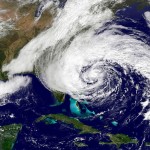
Hurricane Season
For more information » click here
‘Alarming’ Ocean Temperatures Suggest This Hurricane Season Will Be a Daunting One
An early forecast from one set of experts sees an above-average hurricane season that may rival the busiest years on record.
A key area of the Atlantic Ocean where hurricanes form is already abnormally warm, much warmer than an ideal swimming pool temperature of about 80 degrees and on the cusp of feeling more like warm bathtub water. These conditions were described by Benjamin Kirtman, a professor of atmospheric sciences at the University of Miami, as “unprecedented,” “alarming” and an “out-of-bounds anomaly.” Combined with the rapidly subsiding El Niño weather pattern, it is leading to mounting confidence among forecasting experts that there will be an exceptionally high number of storms this hurricane season. One such expert, Phil Klotzbach, a researcher at Colorado State University, said in his team’s annual forecast on Thursday that they expected a remarkably busy season of 23 named storms, including 11 hurricanes — five of them potentially reaching major status, meaning Category 3 or higher. In a typical season, there are 14 named storms with seven hurricanes and three of them major. Dr. Klotzbach said there was a “well above-average probability” that at least one major hurricane would make landfall along the United States and in the Caribbean. It’s the Colorado State researchers’ biggest April prediction ever, by a healthy margin, said Dr. Klotzbach. While things could still play out differently, he said he was more confident than he normally would be this early in the year. All the conditions that he and other researchers look at to forecast the season, such as weather patterns, sea surface temperatures and computer model data, are pointing in one direction. “Normally, I wouldn’t go nearly this high,” he said, but with the data he’s seeing, “Why hedge?” If anything, he said, his numbers are on the conservative side, and there are computer models that indicate even more storms on the way.
The United States was lucky in 2023.
Last year was unusual. Though only one hurricane, Idalia, made landfall in the United States, 20 storms formed, a number far above average and the fourth most since record keeping began. Typically, the El Niño pattern that was in force would have suppressed hurricanes and reduced the number of storms in a season. But in 2023, the warm ocean temperatures in the Atlantic blunted El Niño’s effect to thwart storms. That left Idalia as the one impactful storm of the season in the Atlantic, with 12 deaths attributed to it and over $1 billion in damage. It hit in the big bend of Florida, where few people live, and the prevailing thought among hurricane researchers is that the East Coast got lucky, Dr. Klotzbach said. That luck may change this year. The El Niño pattern is dwindling now, and the likelihood of a La Niña pattern emerging during the hurricane season could also cause a shift in the steering pattern over the Atlantic. During an El Niño weather pattern, the area of high pressure over the Atlantic tends to weaken, which allows for storms to curve north and then east away from land. That’s what kept most of the storms last year away from land. A La Niña weather pattern would already have forecasters looking toward an above-average year. The possibility of a La Niña, combined with record sea surface temperatures this hurricane season, could create a robust environment for storms to form and intensify this year. Just because there are strong signals during an El Niño year that one thing will occur, it doesn’t mean the opposite happens during a La Niña year, Dr. Kirtman said. But if the high pressure strengthens and shifts west, it will mean more hurricanes making landfall. The region where storms are most likely to form is often called the “tropical Atlantic,” stretching from West Africa to Central America and between Cuba and South America. During a La Niña year, Dr. Klotzbach said, there’s a slight increase in hurricanes forming in the western side of this main development zone — closer to the Caribbean than to Africa. When a storm forms there, it is more likely to make landfall because it’s closer to land. And while it is difficult to predict specific landfalls this far ahead of the season, the sheer odds of more storms increases the expected risk to coastal areas. Sea surface temperatures also affect the hurricane season. Over the past century, those temperatures have increased gradually. But last year, with an intensity that unnerved climate scientists, the warming ratcheted up more rapidly. And in the main area where hurricanes form, 2024 is already the warmest in a decade. “Crazy” is how Dr. Kirtman described it. “The main development region is, right now, warmer than it’s historically been,” he said. “So, it’s an out-of-bounds anomaly.” There is little doubt in his mind that we are seeing some profound climate change impacts, but scientists don’t know exactly why it is occurring so quickly all of a sudden. But it is happening, and it is likely to affect the season. “The chances of a big, big hurricane that has a large impact making landfall is definitely increased,” he said.
Early forecasts aren’t always right.
It’s reasonable to take this forecast with a grain of sea salt; the seasonal forecast in April hasn’t always been the most accurate. Colorado State University’s April forecast for the 2023 hurricane season called for a slightly below-average season with 13 named storms. Instead, there were 20. Even Dr. Klotzbach admits the April forecast isn’t always the best prediction, but its accuracy is improving. The weather can be fickle, and much can change before the season officially begins on June 1. The National Oceanic and Atmospheric Administration will issue its own forecast in late May. But for now, Colorado State and a few other forecasting groups have all called for one of the busiest seasons on record. By year’s end, Dr. Klotzbach said, he’ll be writing a scientific paper on one of two things: the incredibly active hurricane season of 2024, or one of the biggest head fakes in Atlantic hurricane season history. But he’s pretty confident it will be the former. “If it turns out to be two hurricanes,” he said, “then I should just quit and do something else.”
Read more » click here
The 2024 hurricane season could be busy.
Here’s what to expect in North Carolina.
“This is the highest prediction for hurricanes that (Colorado State University) has ever issued with their April outlook.”
The start of the 2024 hurricane season is sneaking up just as the weather warms, and forecasters are already out with their early-season predictions. But with climate change warming the oceans and air temperatures seemingly hitting new highs every month, with the European Union’s climate service declaring March to be the 10th consecutive month of record worldwide temperatures, is it only a question of how bad things will be this year? Or will Southeastern North Carolina be able to (mostly) dodge the proverbial storm bullet for another year?
What are forecasters saying?
According to forecasters at Colorado State University (CSU), who have been releasing April predictions since 1995, the 2024 season will be “an extremely active Atlantic hurricane season.” The researchers are predicting 23 named storms, with 11 becoming hurricanes and five of those becoming Category 3 or stronger systems. That’s about 170% of the usual storm activity of an average year. “This is the highest prediction for hurricanes that CSU has ever issued with their April outlook,” stated the researchers in a release.
The probability of one of those storms making landfall on the mainland U.S.:
- 62% for the entire U.S. coastline (average from 1880–2020 is 43%).
- 34% for the U.S. East Coast, including the Florida peninsula (average from 1880–2020 is 21%).
- 56% probability a hurricane will come within 50 miles of the N.C. coast, 85% for a named tropical storm.
The researchers added that the predicted storm activity is exhibiting characteristics similar to the 2010 and 2020 seasons.
How bad were 2010 and 2020?
For the Wilmington area, the 2010 hurricane season didn’t bring too many impacts − although Tropical Storm Nicole did drop more than 22 inches of rain on the Port City, flooding more than 100 roads in Brunswick County and leaving chunks of Pleasure Island underwater. But for the Atlantic basin as a whole, it was very busy, with some of the more brutal storms, particularly Alex and Karl, hammering the Caribbean and Mexico’s Yucatan Peninsula. A pair of Category 4 monsters, Danielle and Earl, also luckily stayed out mostly at sea. A decade later, 2020 proved to be the most active hurricane season ever with 30 named storms, 14 of which developed into hurricanes. That list included a record 12 U.S. landfalling storms, including Hurricane Isaias, which raked the Brunswick County beaches and knocked out power to nearly 400,000 customers in the Carolinas.
What about El Niño & La Niña in 2024?
While El Niño conditions have dominated for the past year or so, that should transition into La Niña by the time hurricane season rolls around. Dr. Michael Mann, a meteorologist and scientist at the University of Pennsylvania, said that will mean decreased wind shear in the tropical Atlantic and a more favorable environment for tropical cyclones.
Did we learn anything from the 2023 season?
Unfortunately, Mann said one of the lessons that last season reinforced was that in a world buffeted by climate change forecasters continue to have a tendency to under predict the actual number of named storms. He added that while ocean surface temperatures are somewhat retreating from the record heat we’ve seen recently, his team is still expecting to see abnormally warm water temperatures in the main development region of the Atlantic for storms. In other words, it could be a long, stormy season − so buckle up and be prepared. “It takes only one storm near you to make this an active season for you,” said CSU meteorologist Dr. Michael Bell. Hurricane season starts June 1 and runs through November.
Read more » click here
NOAA predicts above-normal 2024 Atlantic hurricane season
La Nina and warmer-than-average ocean temperatures are major drivers of tropical activity
NOAA National Weather Service forecasters at the Climate Prediction Center predict above-normal hurricane activity in the Atlantic basin this year. NOAA’s outlook for the 2024 Atlantic hurricane season, which spans from June 1 to November 30, predicts an 85% chance of an above-normal season, a 10% chance of a near-normal season and a 5% chance of a below-normal season. NOAA is forecasting a range of 17 to 25 total named storms (winds of 39 mph or higher). Of those, 8 to 13 are forecast to become hurricanes (winds of 74 mph or higher), including 4 to 7 major hurricanes (category 3, 4 or 5; with winds of 111 mph or higher). Forecasters have a 70% confidence in these ranges. The upcoming Atlantic hurricane season is expected to have above-normal activity due to a confluence of factors, including near-record warm ocean temperatures in the Atlantic Ocean, development of La Nina conditions in the Pacific, reduced Atlantic trade winds and less wind shear, all of which tend to favor tropical storm formation. “With another active hurricane season approaching, NOAA’s commitment to keeping every American informed with life-saving information is unwavering,” said NOAA Administrator Rick Spinrad, Ph.D. “AI-enabled language translations and a new depiction of inland wind threats in the forecast cone are just two examples of the proactive steps our agency is taking to meet our mission of saving lives and protecting property.” “Severe weather and emergencies can happen at any moment, which is why individuals and communities need to be prepared today,” said FEMA Deputy Administrator Erik A. Hooks. “Already, we are seeing storms move across the country that can bring additional hazards like tornadoes, flooding and hail. Taking a proactive approach to our increasingly challenging climate landscape today can make a difference in how people can recover tomorrow.” As one of the strongest El Ninos ever observed nears its end, NOAA scientists predict a quick transition to La Nina conditions, which are conducive to Atlantic hurricane activity because La Nina tends to lessen wind shear in the tropics. At the same time, abundant oceanic heat content in the tropical Atlantic Ocean and Caribbean Sea creates more energy to fuel storm development. This hurricane season also features the potential for an above-normal west African monsoon, which can produce African easterly waves that seed some of the strongest and longer-lived Atlantic storms. Finally, light trade winds allow hurricanes to grow in strength without the disruption of strong wind shear, and also minimize ocean cooling. Human-caused climate change is warming our ocean globally and in the Atlantic basin, and melting ice on land, leading to sea level rise, which increases the risk of storm surge. Sea level rise represents a clear human influence on the damage potential from a given hurricane.
Enhanced communications in store for 2024 season
NOAA will implement improvements to its forecast communications, decision support and storm recovery efforts this season. These include:
- The National Hurricane Center (NHC) will expand its offering of Spanish language text products to include all Public Advisories, the Tropical Cyclone Discussion, the Tropical Cyclone Update and Key Messages in the Atlantic basin.
- Beginning on or around August 15, NHC will start to issue an experimental version of the forecast cone graphic that includes a depiction of inland tropical storm and hurricane watches and warnings in effect for the continental U.S. Research indicates that the addition of inland watches and warnings to the cone graphic will help communicate inland hazards during tropical cyclone events without overcomplicating the current version of the graphic.
- This season, the NHC will be able to issue U.S. tropical cyclone watches and warnings with regular or intermediate public advisories. This means that if updates to watches and warnings for storm surge or winds are needed, the NHC will be able to notify the public in an intermediate advisory instead of having to wait for the next full advisory issued every 6 hours.
New tools for hurricane analysis and forecasting this year
- Two new forecast models developed by NOAA researchers will go into operation this season: The Modular Ocean Model or MOM6 will be added to the Hurricane Analysis and Forecast System to improve the representation of the key role the ocean plays in driving hurricane intensity. Another model, SDCON, will predict the probability of tropical cyclone rapid intensification.
- NOAA’s new generation of Flood Inundation Mapping, made possible through President Biden’s Bipartisan Infrastructure Law, will provide information to emergency and water managers to prepare and respond to potential flooding and help local officials better prepare to protect people and infrastructure.
- NOAA’s Weather Prediction Center, in partnership with the NHC, will issue an experimental rainfall graphic for the Caribbean and Central America during the 2024 hurricane season. This graphic provides forecast rainfall totals associated with a tropical cyclone or disturbance for a specified time period.
System upgrades in operation
NOAA will upgrade its observing systems critical in understanding and forecasting hurricanes. These projects will provide more observations of the ocean and atmosphere in the Caribbean, the Gulf of Mexico, on the U.S. East Coast and in the tropical Atlantic.
- NOAA’s National Data Buoy Center recently upgraded many coastal weather buoys in the tropical western Atlantic and Caribbean to include time of occurrence and measurements of one-minute wind speed and direction, 5-second peak wind gust and direction and lowest 1-minute barometric pressure to support tropical cyclone forecasting.
- New this year, NOAA will gather additional observations using Directional Wave Spectra Drifters (DWSDs), deployed from the NOAA P-3 hurricane hunter aircraft and in the vicinity of Saildrones, uncrewed surface vehicles which will be deployed at the start of the hurricane season, providing one-minute data in real time. 11-12 Saildrones are planned for deployment in 2024.
- Starting in June, dozens of observational underwater gliders are planned to deploy in waters off the Caribbean, Gulf of Mexico and the eastern U.S. coast. Additionally, a new lightweight dropsonde called Streamsonde will be deployed into developing tropical storms, collecting multiple real-time observations to collect valuable wind data.
- The CHAOS (Coordinated Hurricane Atmosphere-Ocean Sampling) research experiment aims to improve the understanding of air-sea interactions, providing sustained monitoring of key ocean features.
About NOAA seasonal outlooks
NOAA’s outlook is for overall seasonal activity and is not a landfall forecast. In addition to the Atlantic seasonal outlook, NOAA also issues seasonal hurricane outlooks for the eastern Pacific, central Pacific and western north Pacific hurricane basins. NOAA’s Climate Prediction Center will update the 2024 Atlantic seasonal outlook in early August, prior to the historical peak of the season.
Read more » click here
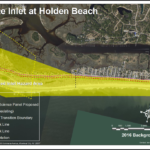
Inlet Hazard Areas
For more information » click here
.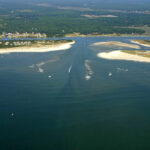
Lockwood Folly Inlet
For more information » click here.

Seismic Testing / Offshore Drilling
For more information » click here.

Offshore Wind Farms
For more information » click here
Things I Think I Think –
 Eating out is one of the great little joys of life.
Eating out is one of the great little joys of life.
Restaurant Review:
The Dinner Club visits a new restaurant once a month. Ratings reflect the reviewer’s reaction to food, ambience and service, with price taken into consideration.
///// June 2022
Name: Port Land Grille
Cuisine: Progressive American
Location: 1908 Eastwood Road
Contact: 910.256.6056 / https://www.portlandgrille.com/
Food: Average / Very Good / Excellent / Exceptional
Service: Efficient / Proficient / Professional / Expert
Ambience: Drab / Plain / Distinct / Elegant
Cost: $45 Inexpensive <=20 / Moderate <=26 / Expensive <=35 / Exorbitant <=60
Rating: Four Stars
Port Land Grille, which opened in 2000 is located in Lumina Station. They offer a progressive American regional cuisine, boasting a broad menu with from the port, from the land, and from the grille selections, offering creative cuisine with something for everyone. An open kitchen and bar separate the two dining rooms. Vintage photographs from Wilmington’s past line the walls. The restaurant itself is a pleasant blend of understated elegance, a casual coastal ambience. One of the area’s most popular fine dining restaurant, they set the standard for what local fine dining should be. Port Land Grille is on our short list of favorite restaurants, dining there is always a pleasure.
New era blends seamlessly with the previous at this prestigious Wilmington restaurant
In 2000, Anne Steketee and Shawn Wellersdick opened Port Land Grille in Wilmington’s Lumina Station with a food-forward vision. The experienced restaurateurs created a fine dining destination near Wrightsville Beach that has served locals, tourists and stars and helped train chefs and servers who have continued to develop the local food scene. When Wellersdick died in May 2022, however, that vision was challenged. Fortunately, the couple had already met the chef who would help fill the void. Chef Jonathan McAuley had a chance to train with Wellersdick for a few months after the mentor was diagnosed with an aggressive form of brain cancer. “And Jon was just able to take Shawn’s vision and make it his own,” Steketee said. While McAuley is a bit shy and doesn’t like the spotlight, Steketee said that his training and passion for what he does shines through. The chef de cuisine has worked in a number of kitchens, including with chef Jessica Cabo at Blockade Runner Beach Resort. While some of the familiar dishes like the Famous “Redneck” Eggrolls and Shawn’s Smooth Pate are still on the menu, diners will also see entrees like Korean BBQ Glazed Short Ribs and specials like Green Gumbo with andouille sausage, blackened shrimp, and Carolina gold rice or the N.C. grouper with yellow curry and butternut squash. The menu and atmosphere maintain the progressive American edge that Port Land Grille had when it was founded at 1908 Eastwood Road. They sourced seasonal and local ingredients before farm-to-table was a part of the national vocabulary and developed an award-winning wine program. Steketee said that goal remains. Along with McAuley, she’s also brought manager Eric Stimson on board. “Eric has been there day in and day out and helpful with everything from the staff to the wine,” she said. Steketee said she needed to rethink a few things about the restaurant but has managed to move from one vision to the next fairly seamlessly, she said. “So much has changed,” she said. “But we are a family. It was always a family… but now it’s just a different family.”
Read more » click here
Dining Guide – Local
Old places, New faces
Name: SmacNally’s
Location: 1045 B-Var Road, Supply NC
This spot that was once known as Betty’s Waterfront Restaurant before reopening in 2020 as LouLou’s Waterfront Restaurant. LouLou’s has permanently closed. They weren’t closed long before a new eatery was announced for the space. Owners of SmacNally’s Waterfront Bar & Grill are planning a second location for 1045 B-Var Road S.W. in Supply.
Popular Outer Banks seafood restaurant planning a second location in Brunswick County
For 25 years, SmacNally’s Waterfront Bar & Grill has been serving fresh seafood and burgers in Ocracoke. Now, the owners are planning to expand the brand for the first time, and they’ll be doing so in Brunswick County. Scott McNally announced that they’ll be taking over the recently closed LouLou’s Waterfront Restaurant on the Intracoastal Waterway at 1045 B-Var Road S.W. in Supply. “It’s time,” McNally said. “We’ve put a lot into this brand and it’s time to grow.” McNally has decades of experience in restaurants, and together with partners Tom Burruss, Matt Bacheler and Persell Morgan, they have more than 120 years in hospitality. One caveat is they wanted to continue with the waterfront restaurant tradition that’s close to local seafood. It made the Holden Beach area ideal. “At SmacNally’s we work with fishermen, and we have a fish cleaning counter right at the end of our dock. They bring it right from there, to our restaurant. It’s usually just hours from the ocean.” That dock-to-kitchen model is one they’d like to continue in Holden Beach. If that’s not possible, they still plan to work with local markets for the freshest seafood, he said. LouLous restaurant opened in fall 2020 in what was formerly Betty’s Waterfront Restaurant. The space has indoor and outdoor dining, a bar area and slips for boat parking. McNally said they hope to open the SmacNally’s in May. “Or sooner, if possible,” he said.
Read more » click here
Peach Cobbler Factory
The dessert chain that also has a location in Carolina Beach has opened a mobile unit (with delivery options) in Holden Beach. The menu includes a variety of cobblers, puddings, cinnamon rolls and other desserts at 3247 Holden Beach Road S.W.

Dining Guide – Local * Lou’s Views (lousviews.com)
Dining Guide – North * Lou’s Views (lousviews.com)
Dining Guide – South * Lou’s Views (lousviews.com)
Restaurant Reviews – North * Lou’s Views (lousviews.com)
Restaurant Reviews – South * Lou’s Views (lousviews.com)
Book Review:
Read several books from The New York Times best sellers fiction list monthly
Selection represents this month’s pick of the litter
The crime story trilogy charts Danny Ryan the Rhode Island former dock worker, Irish mob soldier and fugitive from the law who is now a respected businessman and a silent partner in a group that owns two lavish Las Vegas casinos. While each story can be read as a standalone, readers would be best served by reading the trilogy from the beginning.

CITY ON FIRE by Don Winslow
First installment of a planned trilogy about the conflict between two rival crime families in 1986 Providence, Rhode Island. The Murphy and Moretti families have been at odds for years, the two families have managed to coexist and maintain a cooperative business arrangement in the city in relative harmony for decades. The Irish control the docks, while the Italians run the drugs and hijack the trucks. A tenuous peace exists between rival gangs. Everything was copacetic until an incident ignites a full-scale mob war that will see them kill each other, destroy an alliance, and set a city on fire.
 CITY OF DREAMS by Don Winslow
CITY OF DREAMS by Don Winslow
The crime saga continues in this the middle book of a planned trilogy. On the losing side of a bloody East Coast crime war, Danny Ryan is now on the run. He makes the classic migration to California to start a new life. Ryan ends up in Hollywood, where he finds himself investing in a movie called Providence based on his former life and the war between Italian and Irish mobs. By the end of the new novel, Danny and his crew are on the run again, setting the stage for the trilogy’s upcoming conclusion, “City in Ruins.”
 CITY IN RUINS by Don Winslow
CITY IN RUINS by Don Winslow
The third book in the Danny Ryan crime trilogy. Danny has tried to leave his criminal life behind him and thought he had buried his past. But he ruffles feathers when he makes a bid to buy an old hotel on a prime piece of real estate with plans to build his dream resort. Danny does what he can to prevent the power struggle from turning violent, but through a series of catastrophic events that follow, and the revenge sought by figures from his past, it winds up endangering not only his gambling empire but his life and the lives of those he loves.
That’s it for this newsletter
See you next month
Lou’s Views . HBPOIN
. • Gather and disseminate information
. • Identify the issues and determine how they affect you
. • Act as a watchdog
. • Grass roots monthly newsletter since 2008

